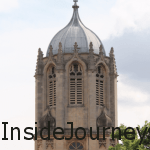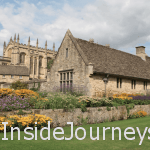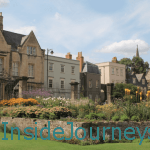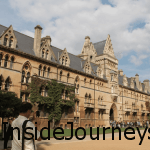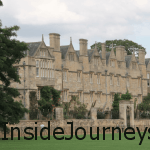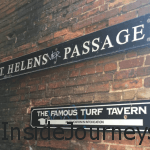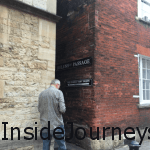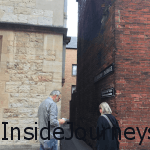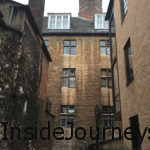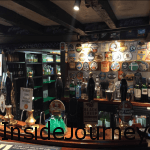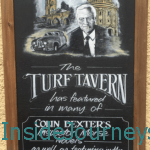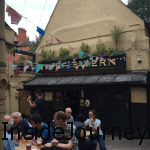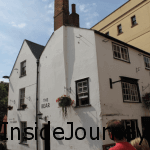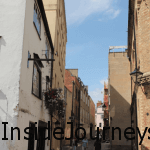Oxford, in my mind, is probably as equally well-known as a university town as it is for the television series about the fictional detective, the opera-loving, often morose, Inspector Morse.
Despite its strong connections to Oxford and the university – Colin Dexter, the author of the novels that the series is based on, worked at the University of Oxford for more than twenty years – Morse, a brilliant and perceptive detective, surprisingly did not receive a degree from any of the city’s famous schools.
I don’t remember much about Oxford from my only visit in the early 1970s but watching the series, which was filmed around the city and the university, made me long to return and do a proper tour.
I found a free 2-hour walking tour with Footprints Tours (If you have a good time, leave us a tip. If not, it was nice to meet you! their website declares) and met the group at Oxford City Center – an easy, 15 minute walk from the train station.
I was late joining the tour and was surprised to hear the guide’s American accent. It felt disorienting to be on a tour of Oxford, England and hear the accent I left in New York. That’s not to take anything away from the guide, who was very enthusiastic, or the tour, which was chock full of history, insider information, and not one boring moment.
Oxford – a short back story
Oxford started humbly, very humbly in AD900 as a river crossing. The name comes from the Old English words (ox/ford) which mean a place (ford) for oxen (ox) to cross. Today, it is a city of approximately 160,000 and home to the University of Oxford, the oldest English-speaking university in the world. The university has been around since at least the 12th century, its earliest colleges – there are 30 of them in all – since the 13th century.
A Few Places to See
The Sheldonian Theatre: Located on Broad Street, The Sheldonian got its name from Gilbert Sheldon, a chancellor at the University of Oxford. The theatre was designed by Sir Christopher Wren (who also designed St. Paul’s Cathedral among other notable buildings). Construction started in 1664 and continued until 1669. The Sheldonian is used for lectures, concerts and graduations.

Thirteen heads, called herms, or termains, philosophers and emperors, each wearing a different beard greet visitors to the Broad Street entrance to the Sheldonian. It’s unclear what they mean or why there are thirteen of them.

Radcliffe Camera: Built between 1737 and 1748, the Radcliffe Camera (Latin for vaulted room or chamber) is a science library. The library got its name from John Radcliffe, a medical doctor who left the funds for its construction.

The Hertford Bridge over New College Lane connects Hertford College’s administrative offices and its students’ accommodations. A popular landmark, it is referred to as the Bridge of Sighs. Just past the bridge, on the left, is the entrance to the alley to Turf Tavern.
Christ Church College: Known officially as The Dean, Chapter and Students of the Cathedral Church of Christ in Oxford of the Foundation of King Henry the Eighth, Christ Church is the only academic institution that is also a cathedral. Part of the University of Oxford, Christ Church is the alma mater of politicians, including several British prime ministers, scientists, philosophers, academics and entertainers.
“Find us if you can, and you’ll be back.”
Turf Tavern: Walk down St. Helens Passage, a narrow alley off Hertford Bridge, and you’ll arrive at The Turf Tavern, an Oxford institution that has been around in one form or another since the 13th century. Once a malt house, a cider house in 1775 and an inn, The Spotted Cow in 1790, it became the Turf Tavern in 1847.
Among the well-known who have passed through its doors – I hope none of them bumped their heads on the low beam near the bar – are Elizabeth Taylor, Margaret Thatcher, Oscar Wilde, Ben Kingsley, and Richard Burton.
The Bear Inn: Dating to 1242, the Bear Inn is the oldest pub in Oxford. It is also well know for its collection of ties from the early 1900s. You can find it on the corner of Alfred and Blue Boar Streets.
I could have spent an entire day walking around Oxford and probably not see the same thing twice. It is a beautiful city with spectacular buildings from all of England’s architectural styles.
Oxford Travel Essentials
Oxford is accessible by train from London’s Paddington Station, and by coach from Victoria, Marble Arch, Notting Hill Gate, Shepherd’s Bush.
Linking this week to Travel Photo Thursday hosted by Nancie at Budget Travellers Sandbox, Ruth at Tanama Tales, Jan at Budget Travel Talk, and Rachel at Rachel’s Ruminations.

